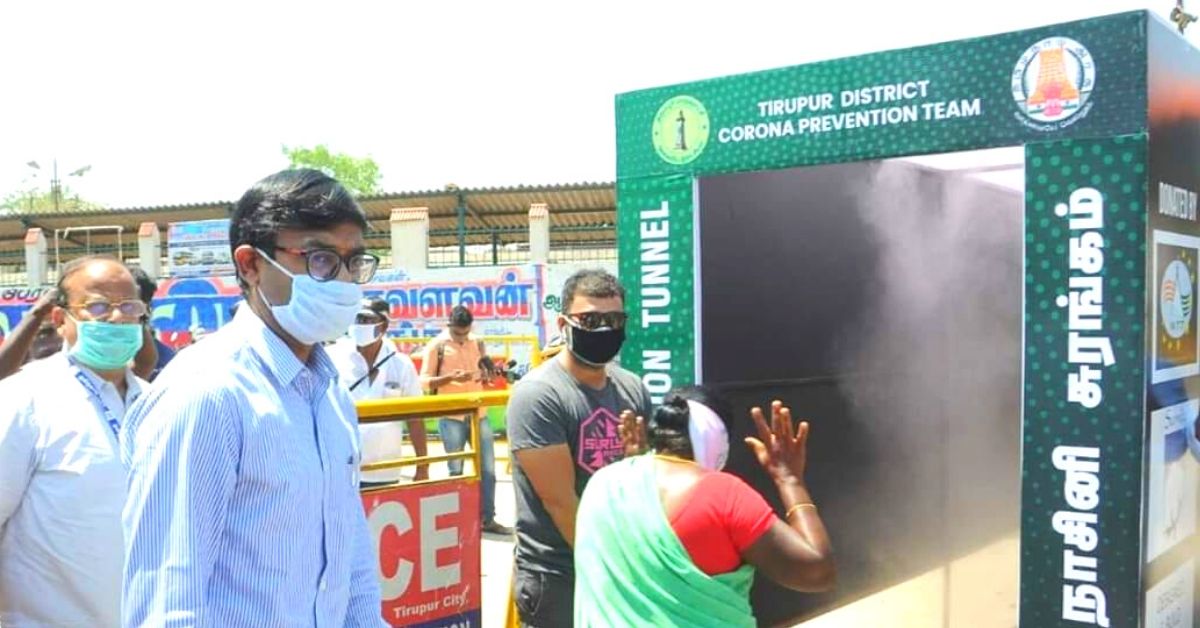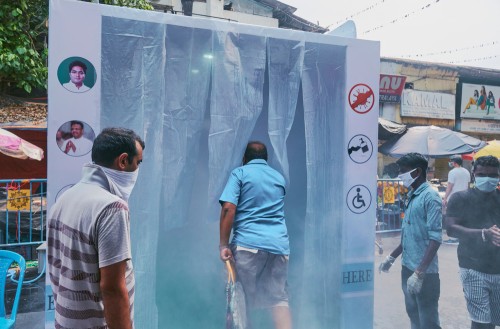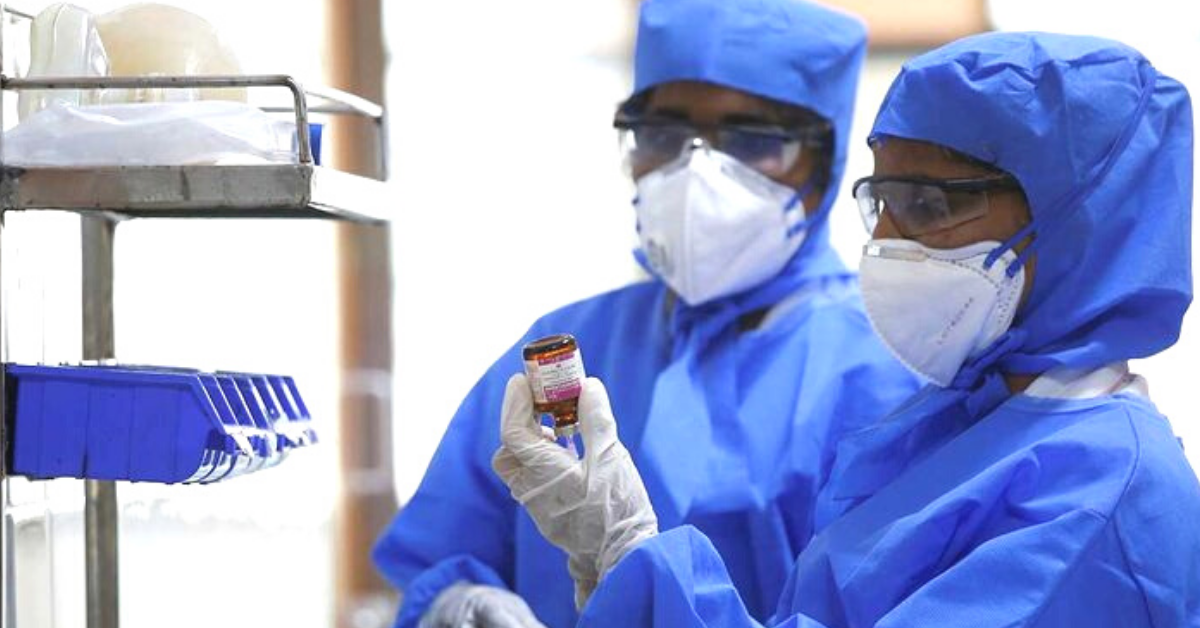Can a Disinfectant Tunnel Protect You? Here’s What You Need to Know
Spraying public spaces with disinfectants and using disinfectant tunnels were hailed as the primary weapons against the spread of COVID-19 in public places. Then why did WHO issue an advisory against them?

On 16 May, the World Health Organisation (WHO) cautioned against large-scale spraying or fumigation in outdoor spaces. “Spraying disinfectants, even outdoors, can be noxious for people’s health and cause eye, respiratory or skin irritation or damage.” The advisory came after many countries like China, South Korea, Italy, South Africa, Israel and India, among others, had already begun spraying disinfectants on roads and sidewalks and installed disinfectant tunnels in most of their cities in their fight against the COVID-19.
Since its spread, the deadly coronavirus has infected more than 68 lakh people worldwide and claimed 3 lakh and 98 thousand lives. In India, of the 236,954 cases reported, 6500 people have died of the virus.
To fight the spread of the virus, the Ministry of Health & Family Welfare (MoHFW) quickly issued guidelines on disinfection of public places including offices. Moreover, once disinfectant tunnels became all the rage in other countries, India too began their installation.
These tunnels spray a mist of sodium hypochlorite solution (a chlorine compound often used as a disinfectant or a bleaching agent) on the people who enter it. Sodium hypochlorite is a component of commercial bleaches and cleaning solutions and used as a disinfectant in drinking and waste-water purification systems and swimming pools.
Costing anywhere between Rs 10,000 rupees to Rs 25 lakh, these tunnels come in various shapes and sizes, and can also be customised depending on the requirement.
Where was the first tunnel installed?

In February this year, China – the epicentre of COVID-19 – installed disinfectant tunnels in the city of Chongqing in a desperate attempt to control the spread of the virus. The tunnels are equipped with infrared detectors that activate a spray from misters when a person enters the tunnel. Other countries were quick to follow suit. From malls, stadiums, airports, bus stations to market places, disinfectant tunnels were installed in important public hotspots.
Back home, India’s first known ‘disinfectant tunnel’ was installed in Tiruppur, Tamil Nadu on 1 April 2020. Following this, many other states soon began setting these tunnels up at market places, and roads.
So what happens when you walk through these tunnels?
Personal Experience
“Have you ever experienced a mist fan or even a face mist? The feeling is similar. The person stationed at the entrance of the tunnel did not give me instructions on how slow or fast to walk. It took me about 8 to 10 steps to exit the tunnel and I continued walking slowly, all the while with my hands raised above my head,” shares Mohit Desai, a resident of the millennium city – Gurugram.
When he was asked to walk through the disinfectant tunnel, they were all the rage in the city, like most others until the advisory came citing terms like ‘skin irritation’, ‘breathing problems’ and ‘health hazard’.
Other than a very mild smell of a sanitiser lingering on your skin and clothes, there is no apparent smell of any chemical, says Mohit who did not experience any adverse effects or irritations post his experience.
Efficacy of Disinfectant Tunnels & Use of Disinfectant Sprays

With the number of these tunnels increasing, several experts started raising concerns on their benefits and warned about their ill-effects. A report in the British-based Occupational Medicine journal stated, “A chemical may be safe when applied topically in liquid form, but extremely toxic when atomised and inhaled.” Some of them even said the chemicals used to spray on humans might be more harmful than the virus itself.
Once the initial euphoria and buzz around these tunnels and spraying of disinfectants lessened, the MoHFW again issued an advisory against the use of Sodium hypochlorite in the disinfectant tunnels: Spraying of individuals or groups with chemical disinfectants can be physically and psychologically harmful and is NOT recommended under any circumstances.
Dr Udgeath Dhir, Director & Head, Cardiothoracic and Vascular Surgeons (CTVS), Fortis Memorial Research Institute, Gurugram, agrees, “The normal tunnels that are being used are more of a hazard rather than a measure for safety.” He emphasises how the coronavirus spreads mainly through aerosol transmission. “These disinfectants may carry harmful chemicals and can affect, skin, eyes, and even lungs of the person who inhale it. Also, it can prove to be carcinogenic in nature. It is also not environmentally friendly,” he shares with The Better India.
Once the Ministry advisory was issued, the state machinery across the country began withdrawing the tunnels installed in the cities.
And what about the spraying of disinfectants in apartment complexes and roads? “Practically speaking, these measures are nothing but an eye-wash. Is it even possible to go around sanitising the universe? It makes sense to disinfect and sanitise hospitals and homes where COVID-19 patients are in self-isolation, but generally to do so is of no use,” he adds.
The issue, as Dr Dhir points out, is that most policies and guidelines are being framed by bureaucrats and not clinicians.

Reiterating what international health organisations have been saying thus far, Dr Dhir says that the only way to protect oneself is by maintaining social distance, washing hands frequently, especially after touching any object.
“One should wear a mask at all times when stepping out of the house,” he advises.
So what are international health bodies saying?

According to the information on the WHO website, spraying of individuals with disinfectants (such as in a tunnel, cabinet, or chamber) is not recommended under any circumstances.
- This practice could be physically and psychologically harmful and would not reduce an infected person’s ability to spread the virus through droplets or contact.
- Even if someone who is infected with COVID-19 goes through a disinfection tunnel or chamber, as soon as they start speaking, coughing or sneezing they can still spread the virus.
- The toxic effect of spraying with chemicals such as chlorine on individuals can lead to eye and skin irritation, bronchospasm due to inhalation, and potentially gastrointestinal effects such as nausea and vomiting.
- In addition to health safety concerns, the use of chlorine in large-scale spraying practices may prevent this resource from being used for important interventions such as drinking water treatment and environmental disinfection of health care facilities
Yet, some scientists have come out in defence of the use of disinfectant tunnels and have questioned the advisories against their use.
The Devil Lies in the Details

After a series of news publications carried articles criticising the use of the disinfectant tunnels, the Pune-based CSIR-National Chemical Laboratory (CSIR-NCL) and the Mumbai-based Institute of Chemical Technology (ICT) issued a joint statement asserting that the advisories “did not have any scientific basis.”
According to the joint statement issued by the institutions, “Efficacy of sodium hypochlorite, also known as hypo or bleach, ranging from 0.02 per cent to 0.05 per cent weight concentration was studied on personnel walking through mist tunnel unit besides antibacterial activity against standard microorganisms before and after exposure in the walk-through,”
“Results indicated that [sodium hypochlorite used in this weight concentration range] did not show any adverse effects on the skin. Thus, we recommend using 0.02 per cent to 0.05 wt. per cent sodium hypochlorite solution (200 to 500 ppm) for external body surface sanitisation of personnel walking through the mist tunnel by following standard safety precautions.”
Not everyone is convinced, however, and efforts are still on to find alternatives to the chemicals being used in the tunnels.
So is Organic the answer?
With the verdict on whether or not these chemical disinfectant tunnels cause harm still being debated, Anantpur district of Andhra Pradesh has installed an organic disinfectant tunnel, which uses CitrobioShield solution in place of the sodium hypochlorite.
While more alternatives are being explored, it is believed that if a person is potentially exposed to the COVID-19 virus, spraying the body will not kill the virus, which is present inside the body.
As advised by doctors and various international health bodies and agencies what is imperative is practising good personal hygiene, washing your hands, staying at home if you are feeling unwell, and practising social distancing at all times.
(Edited by Saiqua Sultan)
Like this story? Or have something to share?
Write to us: [email protected]
Connect with us on Facebook and Twitter.
If you found our stories insightful, informative, or even just enjoyable, we invite you to consider making a voluntary payment to support the work we do at The Better India. Your contribution helps us continue producing quality content that educates, inspires, and drives positive change.
Choose one of the payment options below for your contribution-
By paying for the stories you value, you directly contribute to sustaining our efforts focused on making a difference in the world. Together, let's ensure that impactful stories continue to be told and shared, enriching lives and communities alike.
Thank you for your support. Here are some frequently asked questions you might find helpful to know why you are contributing?


This story made me
-
97
-
121
-
89
-
167














